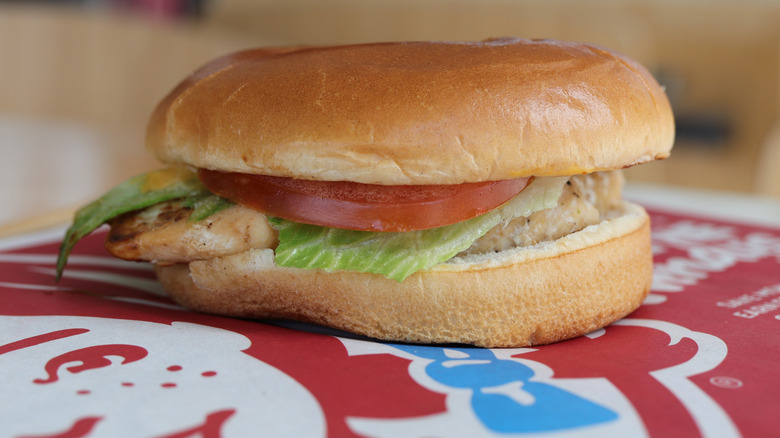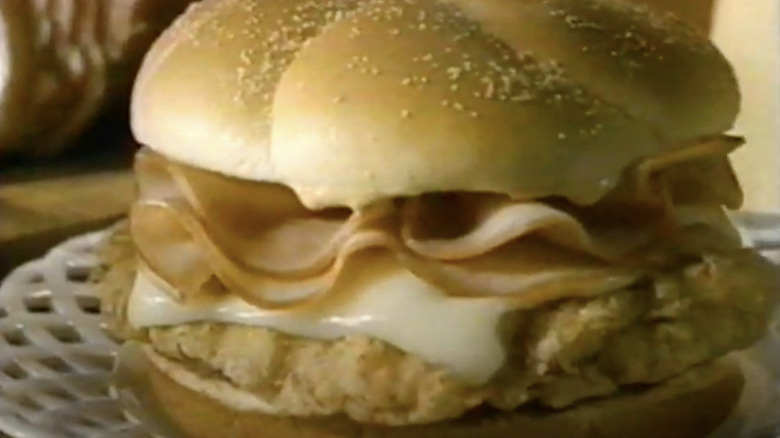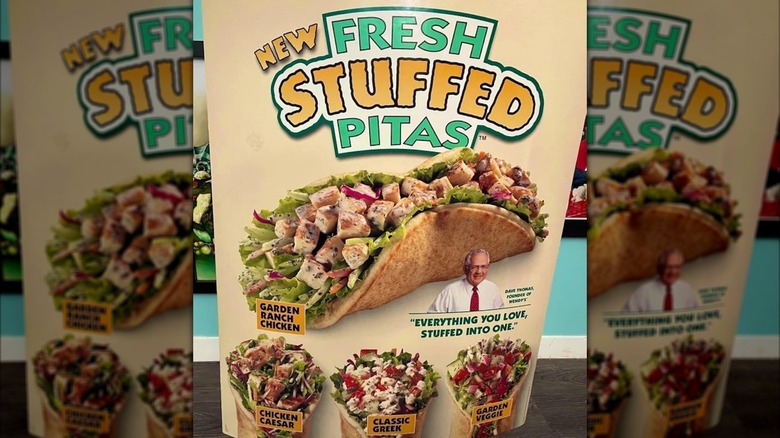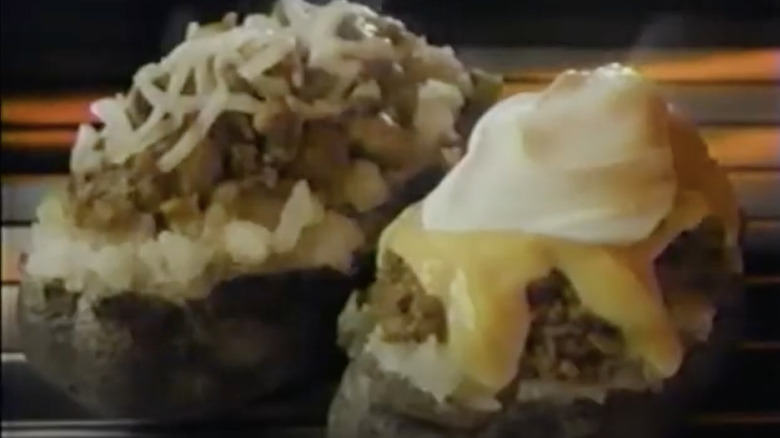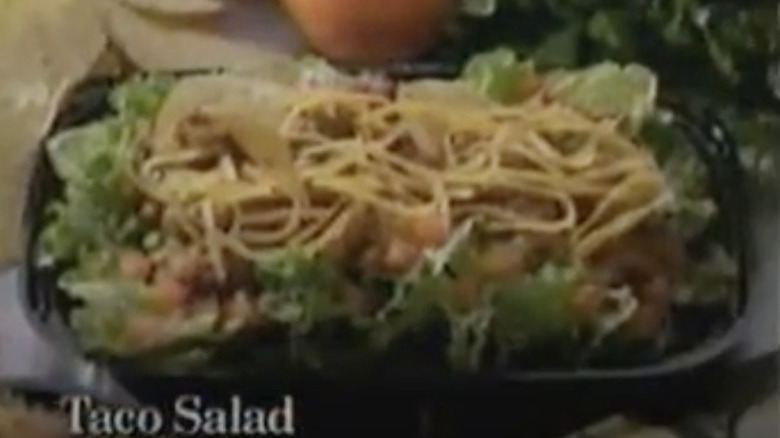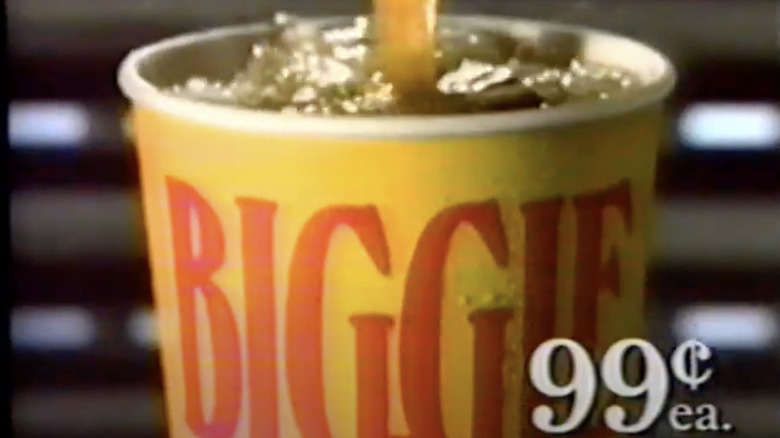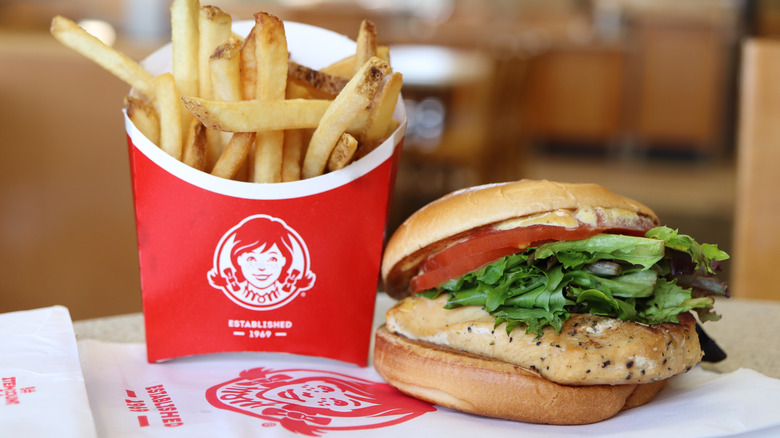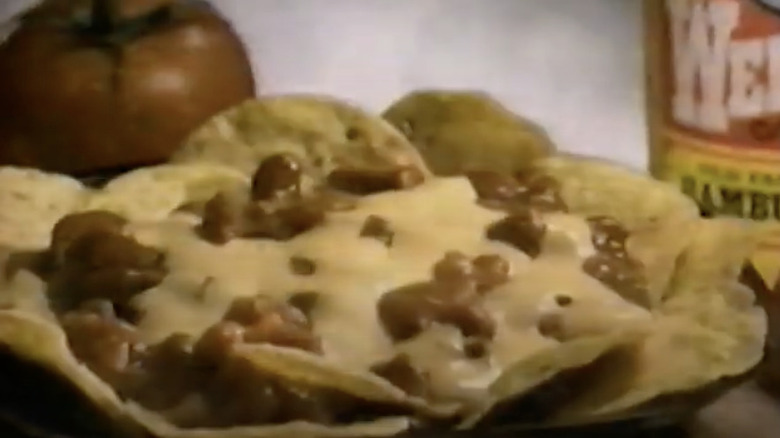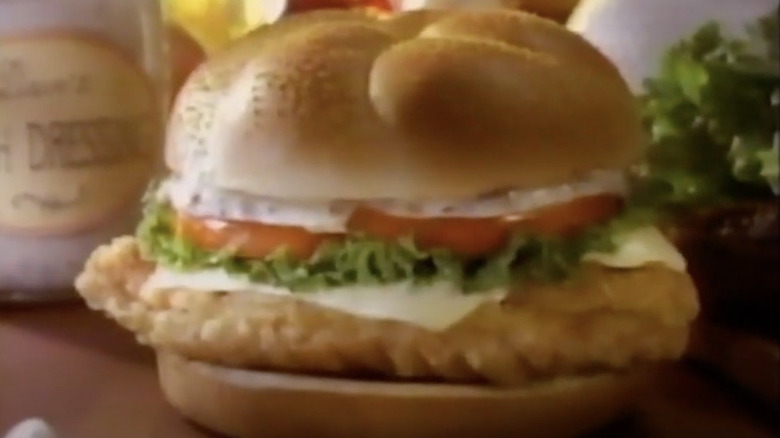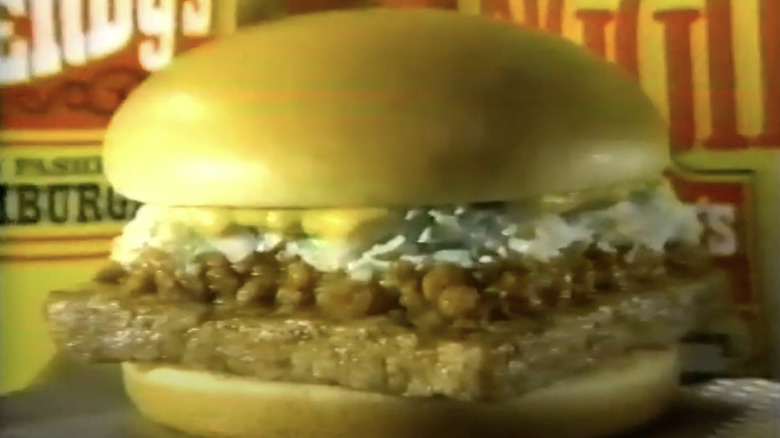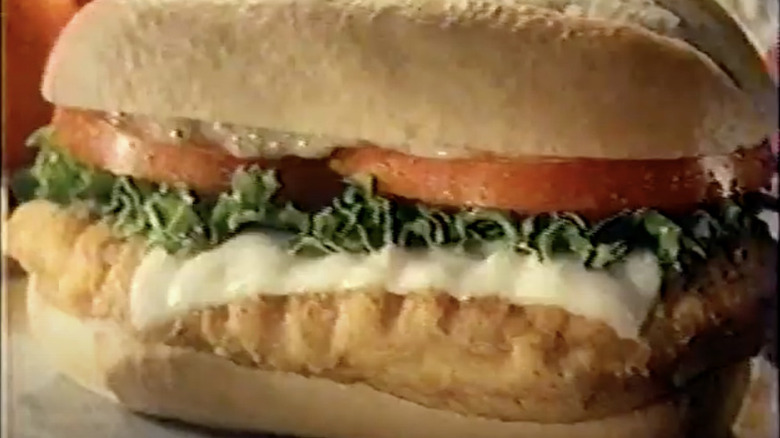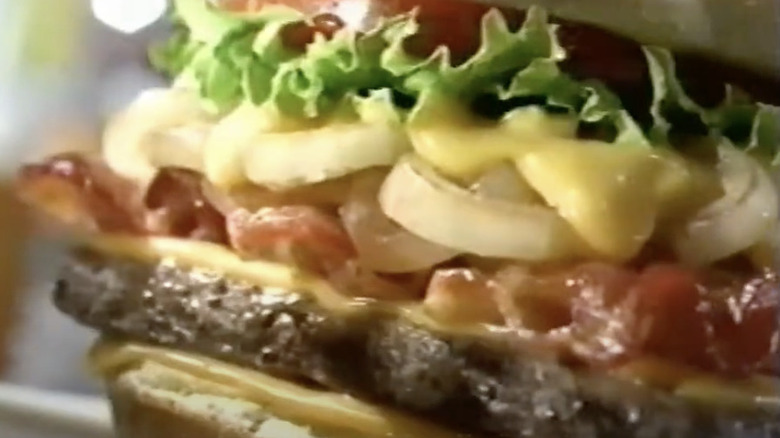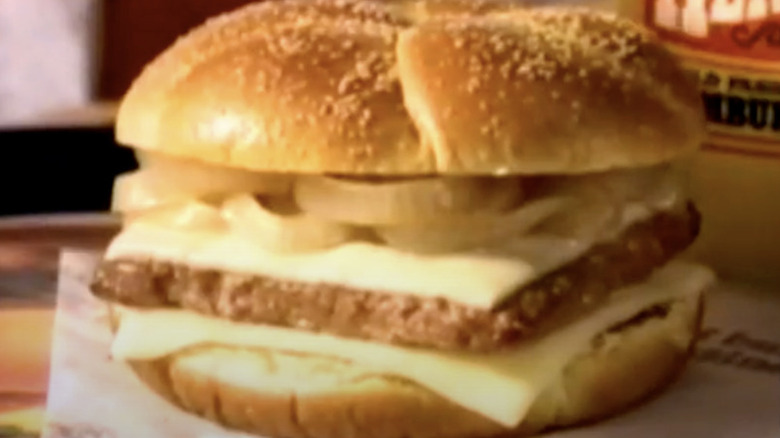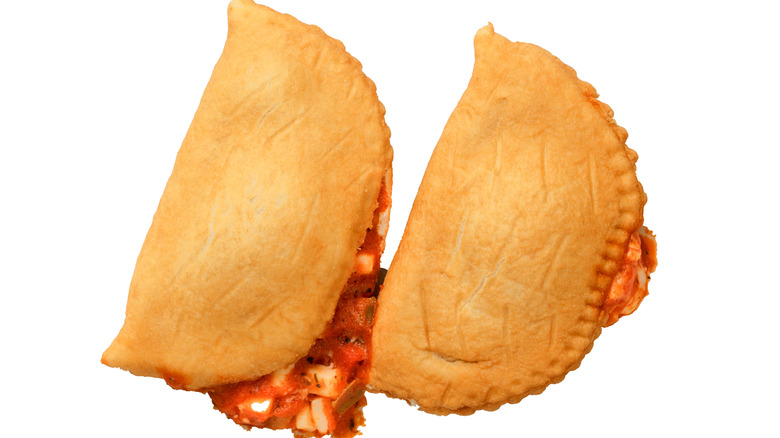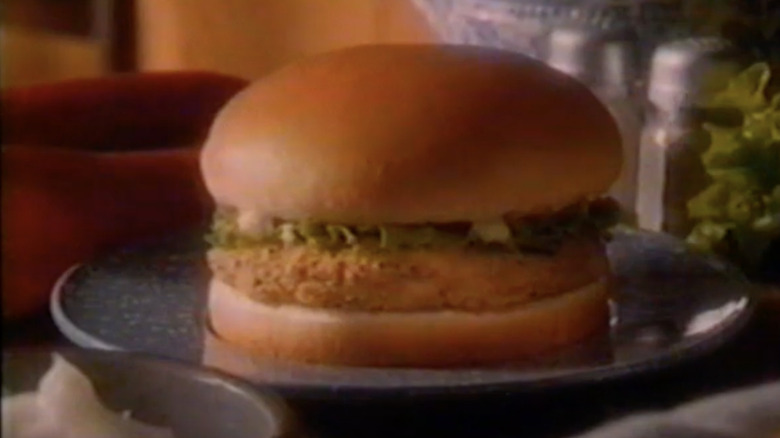14 Forgotten Wendy's Menu Items From The '90s
Wendy's began small and humble, as a single store in Columbus, Ohio, in 1969. Over the next few decades, it grew into one of the biggest fast food companies in the United States, competing directly with juggernauts like McDonald's and Burger King. How did Wendy's do it? The chain set itself apart with menu items that couldn't be found almost anywhere else, from that signature Wendy's chili made with leftover burgers or those mysteriously square Wendy's burger patties to baked potatoes, and the delicious ice cream-like concoction and sometimes shady Wendy's Frosty.
When the 1990s began, and throughout the decade, Wendy's stayed in the hunt and maintained its popularity with an almost constant stream of new products added to the menu. Invariably, folksy founder Dave Thomas appeared in the humorous and wholesome commercials, pitching customers old and new on the latest in Wendy's-based innovations in sandwich, burger, and sides technology.
The chain rolled out so many products in the 1990s that not only was there not enough menu space or bandwidth for them all to stick around forever, but some have been completely swallowed. Here are the 1990s Wendy's items that even the most ardent Wendy's customer may not remember.
Chicken Cordon Bleu
Classic French-style Chicken Cordon Bleu is an underrated old-school chicken dish consisting of a hammered and rolled out boneless chicken breast stuffed with ham, Swiss cheese, and Dijon mustard, and then all of it breaded and lightly fried. That all translates well to a sandwich, or at least Wendy's thought that it did in 1991.
Proclaiming its version of the very old dish to be a progressive and futuristic fast food option, commercials for Wendy's Chicken Cordon Bleu sandwich showed how the fast food chain had translated the recipe. A Kaiser roll served as the foundation for the dish, which made use of a breaded and fried chicken breast filet, along with thinly sliced ham, Swiss cheese, Grey Poupon-branded Dijon mustard, and mayonnaise.
Wendy's only planned to offer the Chicken Cordon Bleu for a little while, but it sold so well and to such a positive response that it made a comeback only a year later. Once again, it was a limited-time deal, and the Chicken Cordon Bleu never came back to Wendy's.
Fresh Stuffed Pitas
Bread that wasn't a bun filled with fresh-cut vegetables, ground beef patties, and fried chicken filets was novel, exciting, and new to pretty much every fast food place that wasn't Subway in 1997. Catering to the idea that more Americans were looking for healthier options when dining out, Wendy's created a line of Fresh Stuffed Pitas in 1997.
Each entry in the line was a loosely constructed sandwich which consisted of a single piece of flatbread topped with lots of lettuce, cheese, and maybe a protein, and then folded over. Customers could choose from the Garden Ranch Chicken (made with ranch dressing and cubed roasted chicken), Chicken Caesar (with poultry and parmesan cheese shreds), Classic Greek (with cucumbers, tomatoes, and feta cheese), and the vegetarian-suitable Garden Veggie.
The Fresh Stuffed Pitas hung around most Wendy's restaurants until 2000, at which point they were abruptly and quietly deleted and never served chain-wide again. Not even online petitions have persuaded Wendy's to return the Fresh Stuffed Pitas to its bill of fare.
Hot Stuffed Potatoes
Wendy's baked potatoes are actually baked in an oven (well, a convection oven), and that unique-to-fast-food line helped set apart the chain from its competition as a place where lower-fat items could be found. Basic hot potatoes proved so popular after their 1983 introduction that in 1990, Wendy's expanded the offerings. Hot Stuffed Potatoes in Italian and Mexican varieties appeared on the menu.
Wendy's ushered in the golden age of fast food buffets in the 1980s with its Superbar, and it had standard Italian and Mexican ingredients on hand for pasta and burrito assembly stations. The Italian Hot Stuffed Potato was piled high with spiced sausage, meaty marinara sauce, and shredded mozzarella cheese. The Mexican version included taco meat, picante sauce, sour cream, and a cheese sauce. While Wendy's would keep baked potatoes on its menu until the present, the Italian and Mexican preparations were ultimately limited-time-only offerings and didn't live to see 1991.
Fresh Salads to Go
Most locations of Wendy's used to have a salad bar as a matter of course, and a more substantial, entree-based buffet called the Superbar. Both fixtures peaked in the 1980s and were in the process of being phased out in the latter decade, and Wendy's decided to concentrate on what was emerging as its core business: drive-through and takeout options. That, coupled with the rise of Americans considering healthier food choices, led to the introduction of Fresh Salads to Go at upwards of 3,500 individual Wendy's outlets in 1992.
The initial lineup of pre-made, packaged greens collections was fairly vast, and it included the Deluxe Garden Salad and Grilled Chicken Salad (both which came with a free breadstick), a Taco Salad, and side sizes of a Garden Salad and Caesar Salad. The prices ranged from 99 cents to $2.99.
Fresh Salads to Go were a big hit for Wendy's. By 1995, the chain was selling more salads than all the other fast food burger chains who'd also introduced the option. In the 2020s, Wendy's still makes ready-to-eat salads, but its current line of Fresh-Made Salads is almost completely different from the one that came out in 1992. A Taco Salad is still on the menu, along with a Cobb, Apple Pecan, and Parmesan Caesar.
Biggie drinks and fries
"Biggie" is a marketing term long associated with Wendy's. Into the 2020s, it sells budget-priced, pre-fixe meals under the name "Biggie Bag," a modern outgrowth of a value-promising menu expansion introduced decades prior. In about 1995, Wendy's debuted "Biggie" fries and drinks, claiming that the new size was so bountiful that it put competitors' value meal sides and beverage sizes to shame. It was all part of a Wendy's marketing campaign pitching "Better food. Better Value" (via YouTube).
Major fast food chains faced a public referendum after the viral popularity of the 2004 documentary-meets-exposé "Super Size Me" suggested that a diet heavy in fast food led to serious and chronic health problems. By 2006, McDonald's had started to get rid of "Supersize" sugary beverages and calorie-laden fries, and it was joined by Wendy's, who announced an end to the Biggie program. But Wendy's didn't get rid of large portions — drinks were still available in a massive cup, but the chain started calling it a "large" size rather than "Great Biggie," and "medium" rather than "Biggie" size.
Grilled Chicken Sandwich
The conventional wisdom surrounding healthy eating in the very early 1990s stated that a diet low in fat was the proper choice. Hoping to not lose business to customers' changing their dietary habits, and to attract the kind of healthy eaters that traditionally eschewed fast food, chains like Wendy's experimented with lower-fat and calorie-reduced items.
In 1990, Wendy's became one of the first major fast food companies to release the now standard issue non-fried hunk of chicken on a bun. Its Grilled Chicken Sandwich consisted of a seasoned and marinated chicken breast filet cooked without the addition of any fat, and topped with lettuce and tomato.
For more than 30 years, the Grilled Chicken Sandwich stayed a stalwart on the Wendy's menu, remaining put among a never-ending parade of fried chicken sandwiches that arrived and departed with regularity. The 300 calorie-range sandwich was a permanent fixture until 2023, when Wendy's discontinued the sandwich in favor of a variant. The Grilled Chicken Ranch Wrap — which transferred most of the ingredients of the original Grilled Chicken Sandwich to a tortilla — is the long-standing item's replacement.
Chili Chips 'n Cheese
Wendy's usually presented itself and operated as a competitor with the big burger giants, but in the 1990s it realized that it may have to stave off a challenger from the field of affordably priced Mexican-inspired fast food. Taco Bell had a big cultural and economic moment in the '90s. Its menu of extremely inexpensive fare likely had something to do with how Wendy's introduced a nachos-like value menu offering made mostly out of ingredients it had laying around the kitchen anyway.
Chili, Chips, 'n Cheese was marketed as Wendy's version of nachos. Costing 99 cents, it consisted of a pile of round corn tortilla chips topped with a helping of Wendy's chili — made up primarily of ground beef, beans, and tomato chunks, all things one could find in restaurant nachos — and all topped with a creamy cheese sauce used on some of the restaurant's burgers.
Despite it being an easy item to make, and being an assembly of inexpensive ingredients, Chili, Chips 'n Cheese never became a Wendy's classic in the way that other off-kilter items like baked potatoes and the Frosty did. They remained on the menu in some locations into the 2000s, and are still sold at Wendy's stores in New Zealand and the Cayman Islands.
Monterey Ranch Chicken Sandwich
Most new fast food menu items demonstrate their appeal quickly. If they sell well, they stay on the menu for a while. If they aren't popular right off the bat, they tend to get pulled out of existence. Then there's the Monterey Ranch Chicken Sandwich at Wendy's. Back in the 1990s, when any kind of a chicken sandwich was a still something of a novelty in the burgers/fries/nuggets-focused world of fast food, Wendy's experimented often with poultry on a bun, adding new and interesting toppings and sauces.
Not long after the Monterey Ranch Chicken Sandwich was launched at Wendy's in 1993, it had become the best-selling non hamburger at the chain. Stuffed into a large kaiser roll came a whole breaded and fried chicken breast filet, a slice of Monterey Jack cheese, bacon ranch dressing, lettuce, and tomato.
Initially available for a limited time, the Monterey Ranch Chicken Sandwich was back at Wendy's by the end of 1995, responding to customer demand. Once more, it disappeared and made another return in 1999, and then in 2011, only to disappear once more into the theoretical Wendy's vault, where it's since remained.
Carolina Classic
The barbecue of the Carolinas, particularly South Carolina, is deliciously unique, and in 1995, Wendy's tried out bringing some of that food culture's quintessential flavors and ingredients to its mass-produced hamburgers. On top of a quarter-pound beef patty, Wendy's stacked slaw, onions, a generous slathering of mustard, and a spoonful of its familiar chili to create the Carolina Classic.
Never a full-time menu item that enjoyed permanent status across the entire Wendy's network, the Carolina Classic was only available for a short period of time. The seasonal product made enough of an impression on customers and the corporate office, however, as Wendy's brought back the Carolina Classic in the fall of 2019. This time, the Carolina Classic Burger was available only at every Wendy's outlet in North Carolina and South Carolina, and once again, for an pre-announced set period of time. The purported fan favorite hasn't been seen at a Wendy's inside or outside of the Carolinas ever since.
Country French Chicken Sandwich
In its ads for the Country French Chicken Sandwich, Wendy's heavily leaned into the Frenchness of it all, relying on a mass, common knowledge of French things that maybe wasn't there. Dave Thomas is depicted going through rigorous French culinary training and language lessons, only to use it all to make a fast food chicken sandwich that by its very nature, is decidedly American. Still, the sandwich itself, introduced and on the Wendy's menu briefly in 1996, was a progressive and intriguing chicken sandwich, a simple construction of a breaded breast filet, a slice of Swiss cheese, green leaf lettuce, and Dijon mustard sauce, placed inside of a flaky French country roll that resembled a smaller, fuller baguette. There was even room for two tomato slices on what was, in a fast food rarity, not a hamburger bun or reasonable facsimile.
The Country French Chicken Sandwich apparently did too many new things at once, because it didn't stick around on the Wendy's menu. And it never returned, despite positive critical reviews.
Cheddar Lovers' Bacon Cheeseburger
In 1999, the fast food powerhouse that would one bring the world the Baconator and the Son of Baconator unveiled one of its earliest attempts at a humongous cheeseburger without any regard for keeping fat or calories to a minimum. Wendy's rolled out the Cheddar Lovers' Bacon Cheeseburger, a sandwich that included three pieces of sliced bacon along with sauteed onions, tomatoes, green leaf lettuce, multiple slices of thin cheddar cheese, as well as a creamy cheddar cheese sauce, all jostling for room inside a cornmeal-speckled Kaiser bun with a substantial quarter-pound patty of ground beef.
A towering monument of fast food excess, the Cheddar Lovers' Bacon Cheeseburger earned some media attention because of its sky-high, for the time, nutritional facts. The sandwich contained 690 calories and 40 grams of fat, making it the unhealthiest item available at Wendy's at the time. Launched as a limited-time offering, Wendy's ultimately decided to not make the Cheddar Lovers' Bacon Cheeseburger a permanent fixture on the menu, despite some promising early feedback.
Wendy Melt
The patty melt is a staple of diners and small, mid-20th century eateries, and Wendy's tried to drum up feelings of nostalgia when it came up with its own version of the sandwich in 1992. An ad rife with 1950s imagery, slang, and cliches attempted to place the patty melt at the center of that era's pop culture, when really it's just a cheeseburger variant that most any fast food place could make if they wanted to, because they have the ingredients already.
The Wendy Melt, as it was billed in a very modern fashion and because founder Dave Thomas thought it "had more zip" according to one commercial (via YouTube), consisted of a quarter-pound patty of beef on a Kaiser bun along with two slices of melty Swiss cheese, sauteed onions, and a specially made orange-colored dressing. Over the past couple of decades, Wendy's has brought out many other sandwiches that it has called melts, but none that quite so readily tried to approximate a diner patty melt. Wendy's didn't make its Wendy Melt for long before it discontinued the sandwich.
Baked Italian Sandwich
For a very short time period in 1991, Wendy's customers could purchase something resembling pizza — or at least a pizza-flavored Hot Pocket — at a handful of the restaurants generally known for its burgers and fries. Wendy's hadn't even settled on a name for the product before it started test-marketing it. One print advertisement called it both a Stromboli and Wendy's Baked Italian Sandwich.
A stuffed sandwich made with Italian-style bread dough, the item was made with Italian cheeses, a light amount of tomato sauce, and the customer's choice of meat-free or the Sausage and Pepperoni Deluxe, which cost an additional 20 cents. Tested for a limited time in Ohio, not far from Wendy's corporate headquarters, the Stromboli a.k.a. the Wendy's Baked Italian Sandwich never made the national menu. It remains a rare misfire for its purveyor, and a fast food obscurity of which there's little record.
Country Fried Steak
Country fried steak, also known as chicken fried steak, is a staple meal in the South and in Texas. It's simply a tenderized and pounded slab of beef, dredged in seasoned flour, and then fried until golden brown and served with mashed potatoes and gravy. A chicken fried steak could be compared to a breaded hamburger patty, and in 1990, Wendy's attempted to expand the reach of the dish by thinking inside the bun. That year it introduced the Country Fried Steak Sandwich.
Debuting at a 99-cent price point and supposedly inspired by the country fried steaks Wendy's founder Dave Thomas had when he was a child, it consisted of a lightly breaded and cooked beef patty between two halves of a bun, topped simply with lettuce and mayonnaise. The Country Fried Steak Sandwich stuck around the Wendy's menu into the early 1990s, even after nutritionists publicly called it out for being one of the most fat-laden options in all of fast food.
